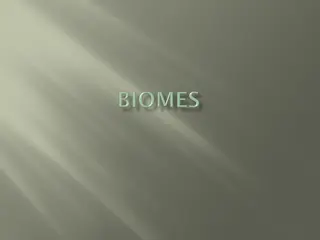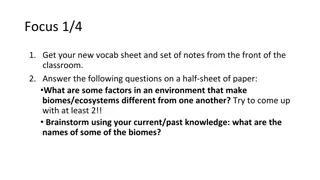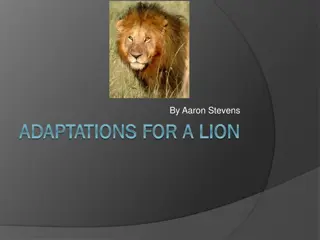The Fascinating Adaptations of Snowshoe Hares in the Taiga Biome
Snowshoe hares in the taiga biome showcase remarkable adaptations to thrive in their environment. Their unique camouflage, population dynamics, and interactions with predators like lynx demonstrate the intricate balance of nature. Discover the secrets of these elusive creatures and their survival strategies amidst changing climates.
Download Presentation

Please find below an Image/Link to download the presentation.
The content on the website is provided AS IS for your information and personal use only. It may not be sold, licensed, or shared on other websites without obtaining consent from the author. Download presentation by click this link. If you encounter any issues during the download, it is possible that the publisher has removed the file from their server.
E N D
Presentation Transcript
The Snowshoe Hare A Study in Adaptations and Climate Change
What do you know about: Snowshoe Hares Camouflage Adaptations
The Snowshoe Hare: Some Background Information The main habitat of the snowshoe hare is a taiga biome. The taiga has warm, humid summers and freezing cold winters. The trees in the taiga biome provide an abundance of undergrowth covering the ground. This undergrowth provides the hares plenty of places to hide and rest during the day. The trees here also provide food for the hares during the winter when the berries and grasses are covered in snow.
The taiga biome supports a wide variety of life. There are predators like the lynx, long-eared owl, and the red fox. There are plenty of prey like the snowshoe hares, squirrels, and voles. The Snowshoe hare is the primary prey species in the taiga and therefore has a large impact on the population of the predator species. Fox, coyote, owls and hawks all feed on them. The Canadian lynx s diet is mostly snowshoe hares.
Snowshoe Hare Interactions Research into the population of the Snowshoe hares show that their population goes through a cycle every 9-10 years. At the top of the cycle there are many hares and at the bottom there are very few. The number of hares in a region affects their predators. When the population of hares is very high at the top of the cycle, the hares starve due to competition for food. They then become weak and are easily caught and then their numbers decrease.
When there are very few rabbits the number of predators like the lynx decreases. This decrease could be due to the animals moving to new hunting grounds or because they starve to death. When food becomes more readily available the hare populations rise again.
Hares are not Rabbits List one characteristic that you think makes hares and rabbits different. Hares have longer ears and legs Hares are larger than rabbits Hares have not been domesticated Hare offspring are born with fur and sight Hares have black markings on their fur Hares have larger, stronger back legs Hares live above ground and most rabbits live in burrows underground Rabbits are live in social groups and hares are live alone except for mating time when they pair up. Rabbits prefer soft stems, grass or vegetables; hares eat more hard food: bark and rind, buds, small twigs and shoots. Hare Rabbit Rabbit Hare
Adaptations There are two types of adaptations, physical and behavioral. For this lesson, we are going to focus on physical adaptations. Physical adaptations are the traits that allow an animal to obtain food, keep safe, build homes, withstand weather, and attract mates. These traits do not develop in one animal s lifetime but over many generations of the species.
Brainstorm some ways that the hares have adapted to survive in the Taiga. Use this image to help.
Snowshoe hares have developed several ways to enhance their survival in the harsh unforgiving taiga. The adaptation is their namesake is their large hind feet that can be spread out like snowshoes. During the winter their feet are covered in thick white hair. This adaptation allows them to move quickly across the top of the snow while protecting their feet from the cold.
Hares have two kinds of waste pellets (soft and hard). The hares will eat their soft droppings to extract additional nutrients that they couldn t get the first time they digested the food. The hard droppings are left behind.
Baby hares, or leverets, are born eyes open and completely covered in hair. They are able to hop around a few hours after they are born and are able to leave their parents and be on their own after four weeks. Look it up: What word describes the type of baby the snowshoe hares have?
Another adaptation that has allowed for the hares survival is a change in coat colors during different seasons. This change from brown to white and back gives their hares their alternative name, the varying hare. When the length of the day changes, so does the hare s coat. Temperature may also be a factor in the coat color change. During a ten week period of time in the fall and spring, the hares develop their thick white coat or their thin brown coat.
Photo: Snowshoe hare sitting in the snow Their thick white coat allows them to stay warm in the freezing winter months and also gives them camouflage.
Their thin brown coat allows them to blend in with the soil and trees and is cooler in the warmer temperature.
Climate Change Montana, one area where the snowshoe hares live, is experiencing a gradual climate change. Montana has recorded shorter periods of cold temperatures and snow and longer periods of warm weather in many areas. With less snow on the ground, how do you think the snowshoe hares will be affected? Remember that change color based on temperature and the change in day length.
The hares change in fur color is what allows them to hide in the snow or vegetation. If it doesn t snow until later in the winter season, or melts earlier than usual at the end of winter, then the hares could end up white surrounded by dirt and grass. This makes the hares a easier target for predators.
The effect of the hares being better targets means that they will be more likely to get eaten. This will lead to a decrease in population size. What will happen to the population size of the hares common predators? It will most likely decrease as well.
What options do the hares have to increase their survival? They could migrate to a new location. Many species like the pika, the rufous hummingbird, and the sachem skipper butterfly, have already reacted to climate change by shifting their ranges. They could adapt to fit the climate change. In some regions, hares do not change color or only undergo a partial molt. These hares have adapted over time to locations that get no snow and to locations with light snow. Example is the Jackrabbit (really a hare!) Jackrabbit
June 2012 Issue of Texas Parks and Wildlife Magazine http://www.tpwmagazin e.com/digital/2012/jun/
How can they adapt to fit climate change? As mentioned before, the physical traits do not change over the life of a single animal, but over several generations. This is done through the process of natural selection. The hares with favorable traits have a better chance of survival, while the hares with undesirable traits are killed off by predators and do not survive to reproduce. Of course, whether trait is favorable or undesirable is completely based on the environment. Photos by Colin Ruggiero
Whats my future?
Predict the Future! Do you think that eventually, through the process of natural selection, the hares will adapt to this new climate? What coat color adaptation would you think would occur? Do you think humans should intervene to help the hares? Moving the hares to a location that better fits their color change. Identifying hares that may change color at the right time and breeding them in captivity for later release into the wild. What other adaptations could be seen in the hare in the future? Two hares in the process of molting
Researcher Scott Mills is studying the snowshoe hare. He is a wildlife biologist and ecologist. Read more about him and his research at: http://www.cfc.umt.edu/Decs/De tails.php?ID=1135 Learn about wildlife ecology at: http://www.esa.org/education_di versity/explore.php Photo by Colin Ruggiero
I See You! Activity White Construction Paper Trials White Dots (start) White Dots (finish) Brown Dots (start) Brown Dots (finish) 1 20 20 2 3 4 Brown Construction Paper Trials White Dots (start) White Dots (finish) Brown Dots (start) Brown Dots (finish) 1 20 20 2 3 4
CreateaGraph http://nces.ed.gov/nceskids/createagraph/default.aspx?ID=658fc7be8055431493d0c97f8e92745c























